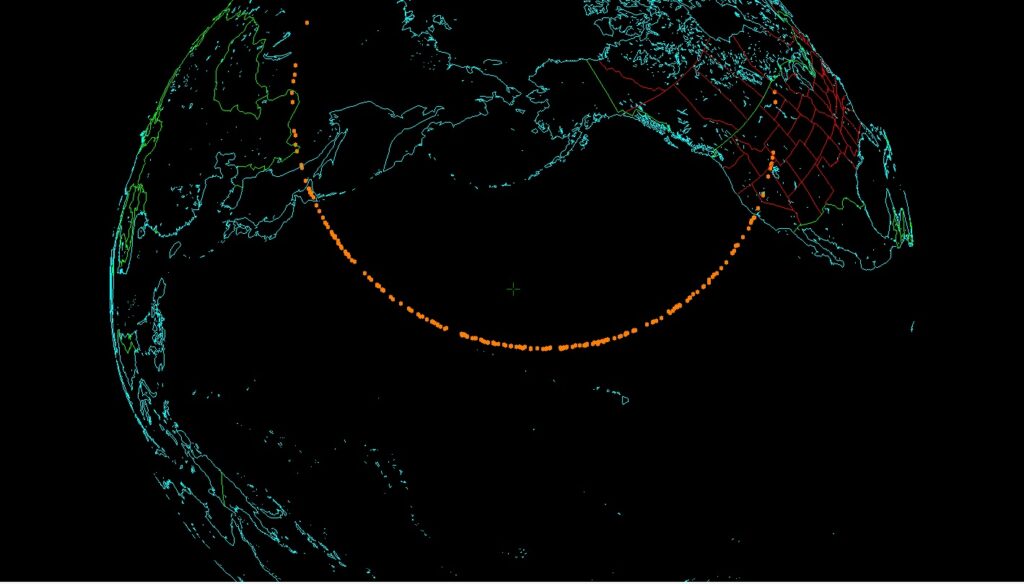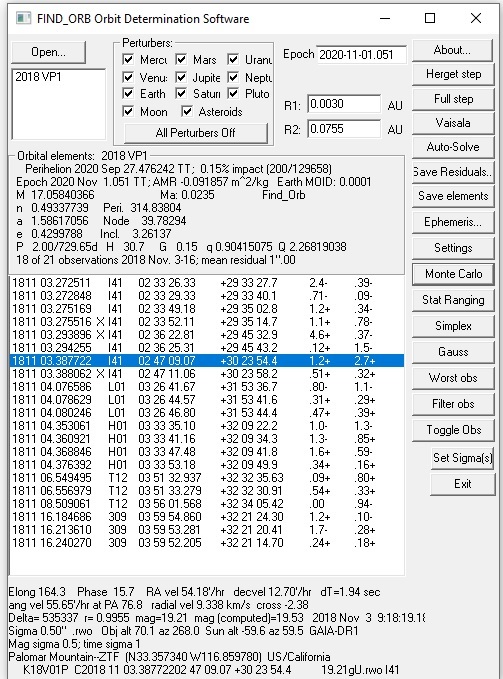
An asteroid (fireball) risk corridor of potential impact for the tiny ~2m NEO 2018 VP1, the orange dots is where 200 virtual impactors strike the Earth’s atmosphere.
The internet is buzzing over an asteroid known as 2018 VP1. In view of all that has happened in 2020, some have personified this year. So when the blogosphere reports that asteroid 2018 VP1 may impact Earth the day before the 2020 Election. Many said see! as I told you 2020 is out to get us. However, like everything one sees on the internet, there is more to the story.
Discovery and Risk Assessment
The Zwicky Transient Facility (ZTF) found an asteroid on 2018-11-03. Visnjan and Magdalena Ridge observatories submitted confirmations observations to the MPC. On 04-11-2018, the MPC issued MPEC 2018-V42: 2018 VP1. This MPEC reported that 2018 VP1 was tiny ~2m and had a small Earth MOID. Shortly after this, the JPL’s Sentry system performed a risk assessment. Within a day ESA also evaluated the risk. In the weeks that follow observation taken with the University of Hawaii’s 2.2-meter telescope and from Cerro Paranal. While NASA JPL and ESA list 2018 VP1 near the “top” when comes to the “odds” of impact [1 in 194 and 1 in 240] it is given low Torino and Palermo ratings. This is because 2018 VP1 is so small and is unlikely it would do any damage if it were to hit.
Torino and Palermo Ratings
When it comes to asteroid risk assessment, there are two commonly used scales. The first is the Palermo Technical Impact Hazard Scale use by NEO specialists to set priorities in planning observations. It compares the risk of the potential impact against the background risk of an object equal to or greater than the potential impactor. This scale is logarithmic so that objects posing less risk than the background are negative and objects posing higher than the background are positive. So -2 is 1% as likely as the background, and +2 would be 100 times more likely than the background.
The second and older scale is the Torino Impact Hazard Scale; it communicates impact risks for the next 100 years to the public. 0n this scale 0 is for objects that are very small or have an impact risk of effectively zero;
Ten is for
“A collision is certain, capable of causing global climatic catastrophe that may threaten the future of civilization as we know it, whether impacting land or ocean. Such events occur on average once per 100,000 years, or less often.”
As of 2020-08-24, no object has a Torino Impact Hazard Scale > 0.
A key point to keep mind is if one spends too much time on any one asteroid they risk missing one that is more dangerous. Give the fact that 2018 VP1 has a PS around -3.5 one could say most of the telescope time should be spent looking for unknown risks. There could be a serendipitous recovery of 2018 VP1 while looking for the new risks. However also posable it will too far away to be imaged in 2020.
Background (as of 2020-08-24)
- Object: 2018 VP1
- Orbit Type: NEO Apollo
- Approximate Diameter: 1.8 m – 3.9 m ( 5.9 to 12.8 feet) (Absolute Magnitude: H=30.9)
- On the Sentry Risk Table: YES
- Impact Probability(2020-11-02.05) = 4.1e-3
- 0.41% chance of Earth impact
- 1 in 240 odds of impact
- Date: 2020-11-02.05
- 99.59% chance the asteroid will miss the Earth
- Torino Impact Hazard Scale: 0
- Palermo Scale (maximum): -3.57
- Palermo Scale (cumulative): -3.57
- for more information read Understanding Risk Pages by Jon Giorgini
- On the NEODyS CLOMON2 risk page: YES
- (2020-11-02.051) 5.16e-3
- 0.516%
- 1 in 194
- Date:2020-11-02.051
- 99.484% chance the asteroid will miss the Earth
- Torino Impact Hazard Scale: 0
- Palermo Scale (maximum): –3.77
- Possible Earth Impact Effects Program of 2018 VP1
- “Energy before atmospheric entry: 1.17 x 10^12 Joules = 0.28 x 10^-3 MegaTons TNT The average interval between impacts of this size somewhere on Earth is 0.2 years [ 2.4 months ]”
Finding The Asteroid (fireball) risk corridor for NEO 2018 VP1
One of the programs available to the amateur observers of asteroids and comets is Find_Orb.[By Bill Gray] It is useful for calculating approximate ephemeris, determining approximate orbits, generating virtual asteroids, virtual impactors, predicting impact locations, and many other things. Find_Orb can generate an “asteroid risk corridor” with the help of Guide 9.1.[By Bill Gray]
As a test of concept, I obtained the observations of 2018 VP1 for the MPC. I loaded the observations into Find_Orb and had it run the Monte Carlo method all night. Find_orb generated the following files MPCOrb.dat, state.txt, and virtual.txt. These files had orbits for 129,659 virtual asteroids 200 were virtual impactors( about 0.15%). I place a copy of the virtual.txt file in the Guide directory along with a copy of impact.tdf.(Project Pluto) Then Guide generated a map of an asteroid risk corridor. (image above)
Note: Because there were more than nine observations, I had to edited virtual.txt to do a workaround. I replace “18 of 21” with “U of O” see edited virtual.txt; this keeps the columns in the right place. I also edited impact.tdf(My) file

My Find_orb Setting
| Selecting perturbers | All |
| Epoch | 2020-11-01.051 |
| Monte Carlo noise | 2 |
| Physical model Include | SRP |
| Filler out | 3 worst observations |
Another program is Solex & Exorb
Peter Thomas @ptastro1 also this path of risk for 2018 VP1 on Twitter
@kpheider asked me to calculate a path of risk for #2018VP1. It’s only a few meters across but JPL’s SENTRY has it at 1 chance in 240 of impacting on Nov 2, 2020 (ESA/NEODys has it at 1 in 400). Path of risk stretches across the Pacific. Calculated with SOLEX 12.1 pic.twitter.com/U8SGb8CvOl
— Peter Thomas (@ptastro1) July 26, 2019
This Asteroid Could Hit Earth Later This Year! Don’t Panic! by Astronomy Live He also generated an asteroid risk corridor.
Sources
- Asteroid (NEO) 2018 VP1 Information (TheSkyLive.com)
- ESA 2018 VP1
- 2018VP1 Impactor Table(EAS)
- 2018 VP1 — Earth Impact Risk Summary
- JPL Small-Body Database Browser (2018 VP1)
- MPC Database Search — 2018 VP1
- Palermo Technical Impact Hazard Scale
- Introduction to Sentry: Earth Impact Monitoring
- Sentry: Earth Impact Monitoring
- Torino Scale
- The Tracking News – Earth’s Busy Neighborhood
Other Useful Links
- Asteroid Hazards: The View from Space(MPC)
- Don’t fear apocalyptic asteroids: you’re safer than you think
- Frequently Asked Questions For Impact Risk Assessment
- NEO Search & Follow-Up
- Palermo Technical Impact Hazard Scale
- Quantifying the risk posed by potential Earth impacts Steven R. Chesley (JPL), Paul W. Chodas (JPL), Andrea Milani (Univ. Pisa), Giovanni B. Valsecchi Icarus 159, 423-432 (2002) ( PDF )
Also, See
The Asteroid 2020 NK1 Has Been Removed From Sentry: Earth Impact Monitoring